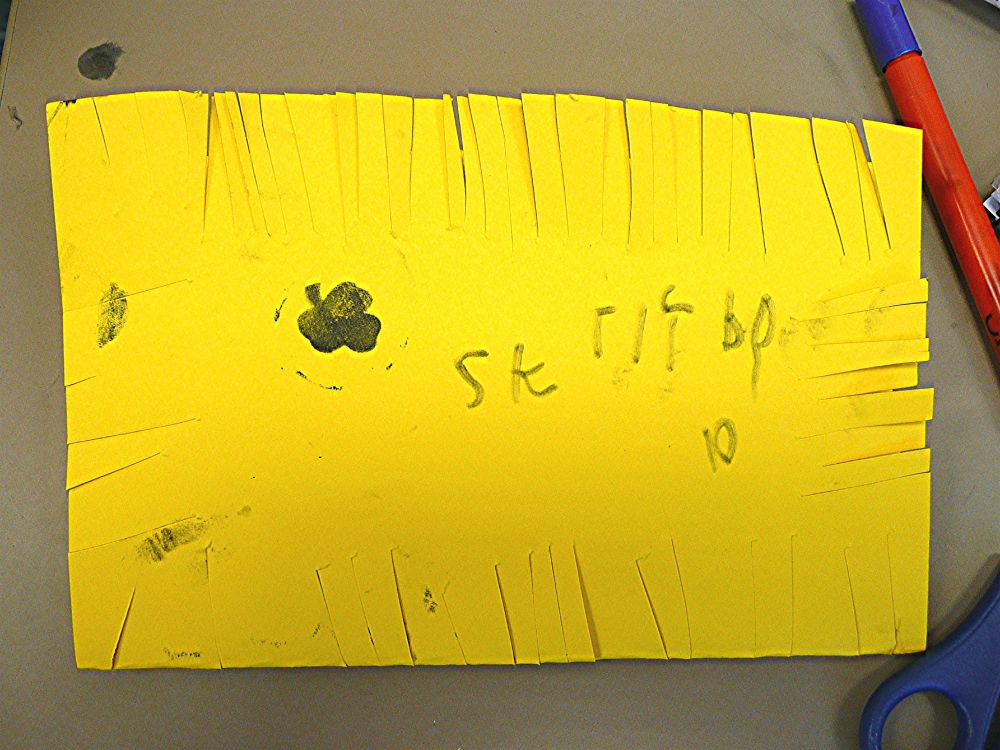www.childrens-mathematics.net
as he wrote a string of letters and numerals, reading
"SK, 714bp10". Lifting his spy gadget to his face he
explained "SK is to keep the password safe. To switch it
on you have to say '714bp10' - and you have to read it
backwards for 'off'"!

as he wrote a string of letters and numerals, reading
"SK, 714bp10". Lifting his spy gadget to his face he
explained "SK is to keep the password safe. To switch it
on you have to say '714bp10' - and you have to read it
backwards for 'off'"!
cheque he wrote a reversed and inverted letter 'a' to signify “£500.00 for all the jobs I've done at my house".
Young children begin to differentiate letter and numerical symbols in meaningful contexts such as their own pretend play.

cheque he wrote a reversed and inverted letter 'a' to signify “£500.00 for all the jobs I've done at my house".
Young children begin to differentiate letter and numerical symbols in meaningful contexts such as their own pretend play.

See: www.childrens-mathematics.net

See: www.childrens-mathematics.net

Three-year-old Finn named his scribble-marks 'night-time'.
Attaching personal meanings to marks is significant in their graphical journey.

Three-year-old Finn named his scribble-marks 'night-time'.
Attaching personal meanings to marks is significant in their graphical journey.
In this example, Barney was playing a dice game, and thinking about 'taking away' some of the beans in his pot, invented an arc of arrows to signify 'take away' - that made real sense to him!

In this example, Barney was playing a dice game, and thinking about 'taking away' some of the beans in his pot, invented an arc of arrows to signify 'take away' - that made real sense to him!
Children's Mathematical Graphics are the missing aspect of early childhood mathematics curricula.
www.childrens-mathematics.net

Children's Mathematical Graphics are the missing aspect of early childhood mathematics curricula.
www.childrens-mathematics.net
Isaac had recently begun to use letter- and numeral-like signs and his sign indicates the amount paid.

Isaac had recently begun to use letter- and numeral-like signs and his sign indicates the amount paid.

She then wrote letters to borrowers, demanding huge fines!

She then wrote letters to borrowers, demanding huge fines!


"That's the number 8, and the other number is 9."
This wasn't about writing 'correct' numerals but her need to associate her house number with her pretend house when playing.

"That's the number 8, and the other number is 9."
This wasn't about writing 'correct' numerals but her need to associate her house number with her pretend house when playing.
“These are ticks. When there are three ticks you can go, when there are two you can’t go that way. I’ve made two ticks - that means you are not allowed. People allowed in that way.”

“These are ticks. When there are three ticks you can go, when there are two you can’t go that way. I’ve made two ticks - that means you are not allowed. People allowed in that way.”
Joolone @joolone.bsky.social - repost
I ask a child: “How could we explore measure?”
A moments silence.
Child: “We could find out how far we can draw a line with a piece of chalk until it’s too small to hold.”
He follows the plan.
Genius.

Joolone @joolone.bsky.social - repost
I ask a child: “How could we explore measure?”
A moments silence.
Child: “We could find out how far we can draw a line with a piece of chalk until it’s too small to hold.”
He follows the plan.
Genius.
Very excited! More to come soon!

Very excited! More to come soon!
Then, drawing a cross over the new face remarked, "Oh dear ... it's closed."

Then, drawing a cross over the new face remarked, "Oh dear ... it's closed."
His teacher had noticed what he was doing, and pointing to the face with a cross over it, Daniel explained, "It's closed now, the shop is closed."

His teacher had noticed what he was doing, and pointing to the face with a cross over it, Daniel explained, "It's closed now, the shop is closed."

This example includes sufficient visual information for us to
'see' his dog, whilst the lack of detail (face, ears and legs) are implied.

This example includes sufficient visual information for us to
'see' his dog, whilst the lack of detail (face, ears and legs) are implied.
Tucking coloured paper in an envelope, Nathan explained it was an astronaut. Saying, "Blast off!" he lifted it above his head making a 'whooshing' sound and announcing, "It's flying to the moon."
Then, lifting the envelope's flap, he explained that the astronaut could get out of his space-suit.

Tucking coloured paper in an envelope, Nathan explained it was an astronaut. Saying, "Blast off!" he lifted it above his head making a 'whooshing' sound and announcing, "It's flying to the moon."
Then, lifting the envelope's flap, he explained that the astronaut could get out of his space-suit.

The spontaneity and originality revealed in children's graphics is often remarkable.
Here a young four-year old explained that his family had been on a car journey that was "very hilly".

The spontaneity and originality revealed in children's graphics is often remarkable.
Here a young four-year old explained that his family had been on a car journey that was "very hilly".


